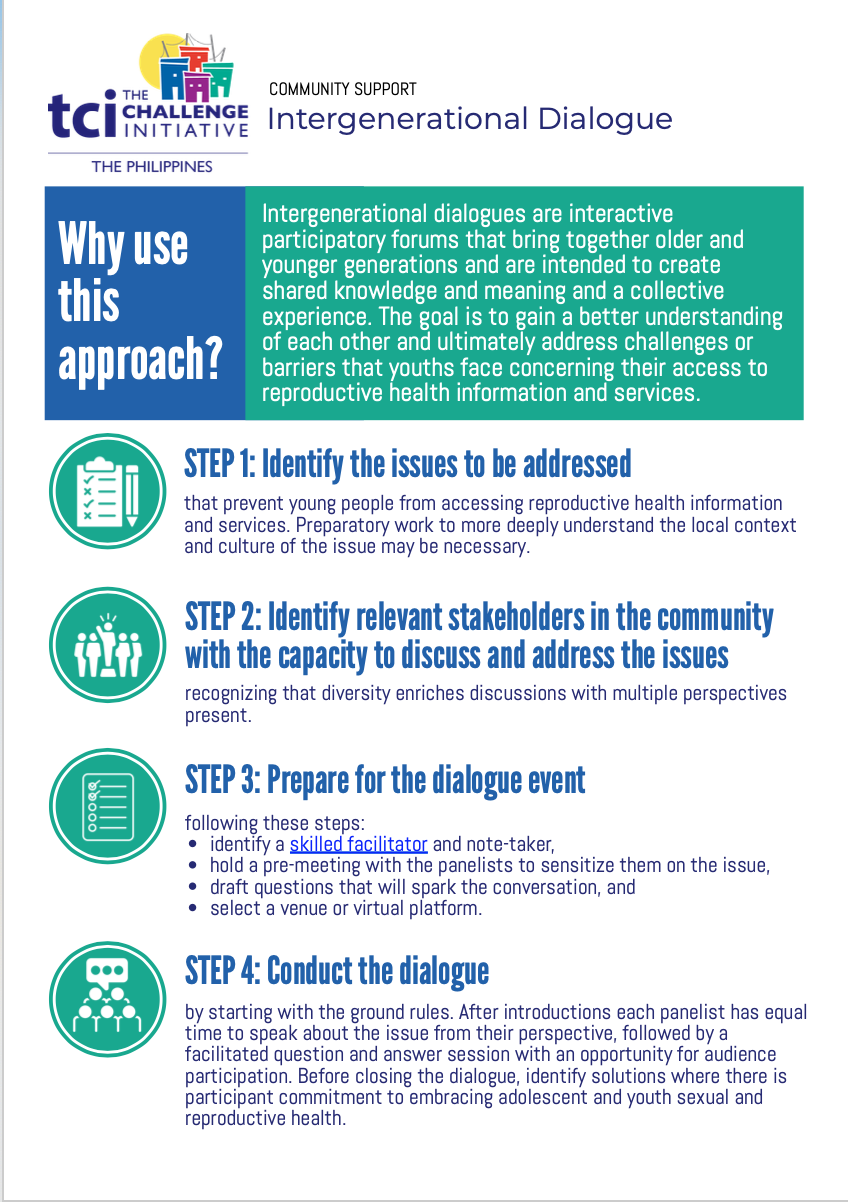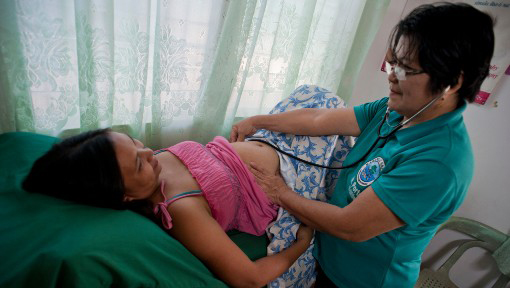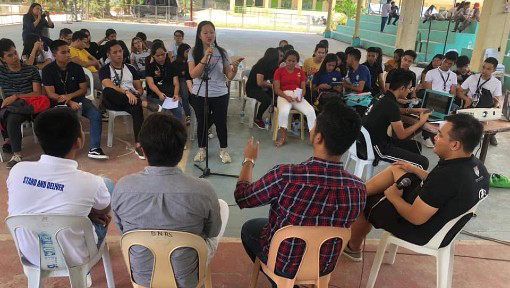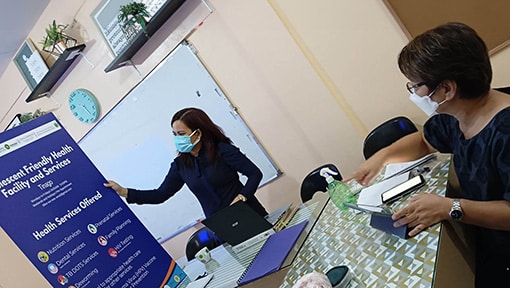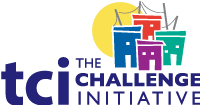Philippines Toolkit: AYSRH Demand Generation
- Home
- Help and Support
- Close
- Toolkits
- Global Toolkit
- AYSRH Toolkit
- Hub Toolkits
- Core High-Impact Practices
- Gender Essentials Mini Course
- Close
- Resource Collection
- Community of Practice
- Coaching
- Log In/Register
- My Profile
- English
Intergenerational Dialogue

Conduct of an intergenerational dialogue (Source: Oro Youth Council).
Intergenerational dialogues are interactive participatory forums that bring together older and younger generations and are intended to create shared knowledge and meaning and a collective experience. The goal is to gain a better understanding of each other and ultimately address challenges or barriers that youths face concerning their access to reproductive health information and services. A community dialogue can be initiated by a youth leader or influencer, a population volunteer/worker or barangay health worker (BHW), or civil society organization (CSO) familiar with the youth’s challenges.
What are the benefits of the intergenerational dialogue?
- Helps improve the youth’s access to reproductive information and services at the community level
- Aids in overcoming cultural and religious challenges and other barriers to the youth’s access to reproductive health information and services
- Sensitizes first-time parents and adults, as gatekeepers of adolescent and youth reproductive health information, on relevant issues
- Creates mutual understanding between different generations or groups in the community
How to implement
Step 1: Identify the issues to be addressed
The barriers can be identified by a youth leader, influencer, other young person, BHWs, population volunteer/worker, other facility health care providers, or CSOs. In rural communities where there are indigenous people, the tribal leader or local religious leader may facilitate the intergenerational dialogue. All these actors can identify the various issues preventing young people’s access to reproductive health information and services. As community change agents and influencers, they organize and facilitate intergenerational dialogues. Before they organize the dialogue, they may need to develop a deeper understanding of the issues by taking part in an empathy walk or a deep dive. Do preparatory work and gain an in-depth understanding of the local context and culture.
| What is a deep dive? |
|
Deep dive is leadership learning journey where the participant or learner directly experiences the challenges of the system from the perspective of the stakeholders. Deep dive is seeing the problem with fresh eyes and sensing from the field. Deep dive allows leaders to: a) move into familiar environments, b) immerse themselves in different contexts, c) step into relevant experiences and d) build relationships with stakeholders and gain a whole system perspective. Reference: Municipal Leadership and Governance Program Version 2, Development Management Officer’s Guide Practicum 1, 1st Edition, 2017. |
Step 2: Identify relevant stakeholders in the community with the capacity to discuss and address the issues
Be strategic in choosing participants for the dialogue. Diversity brings multiple perspectives on the issues and can thus enrich discussions.
Step 3: Prepare for the dialogue event
- Identify a skilled facilitator and a note-taker who are respected members of the community. Alternatively, the facilitator could come from outside the community; however, they should have proper training, such as UNFPA experience/module, and know the local language well, understand the subject matter and the backgrounds of the panelists. Also, consider identifying a youth to serve a the facilitator to increase their standing in the community and make sure the issues affecting youth remain at the forefront of the discussions. Ensure that the youth facilitator is properly trained. This simple guide provides some key points in identifying a good facilitator for intergenerational dialogues and outlining roles and responsibilities.
- Hold a pre-meeting with the panelist to sensitize them on the issue and get their buy-in to the dialogue process.
- Identify possible leading questions that will spark conversations. The developed questions must align with the issues identified in step one.
- Select a venue within the community where participants will feel safe to express themselves freely. Ideally, this is a public, community-owned space. Given the current limitations in face-to-face events, online platforms like Facebook, MS Teams, or Zoom can be used for as long as it is widely available to the different stakeholders/participants.
Step 4: Conduct the dialogue
The facilitator starts by setting the stage and ground rules for the discussion according to the agenda. S/he introduces the panelists and informs the audience as to the purpose of the dialogue, what is the topic that will be discussed and the goal to come to some kind of greater understanding and next steps. Each panelist speaks about the issue from their perspective and who they are representing in the community. Each panelist is given equal time to give their initial remarks and then listen to the others. After the panelists speak, the facilitator facilitates a question and answer session among the panelists to gain further clarification and insights into each perspective as well as takes questions and comments from the audience.
As a result, a typical intergenerational dialogue takes at least 2-3 hours. This ensures sufficient time to hear the perspectives from all of the panelists and allow the opportunity for questions from the audience/community members gathered. Before closing the dialogue, identify solutions where there is a commitment or resolution by the participants to embrace AYSRH/family planning. It may also bring about additional information, issues, and ideas that the community may wish to act on.
Alternatively, a dialogue may be planned as a day or day and a half event, depending on how much background sensitization is required. See this facilitator guide for training community leaders, champions and gatekeepers that may be useful, depending on the issue(s) being addressed and the audience. The Commission on Population and Development also has a bridging session for parents and their adolescent children in its Parent-Teen Talk, which may be used as a way to break communication barriers and foster intergenerational dialogue. In addition, the Usapan presentations and guidance may help in preparing for this approach.
Step 5: Ensure follow-up
Make sure that the facilitator has enough time to share a recap at the end of the dialogue, specifically reviewing the solutions and action points for where there was agreement and next steps, persons responsible and by when, ensuring participants are actively involved. Next steps may include plans for advocacy visits, for example.
Express appreciation to all participants for their time, contribution, and resolve. This should be done regardless of the dialogue outcome. Agree on the date for a follow-up meeting to review next steps and addressing any emerging AYSRH issues.
Indicators for success
The goal of intergenerational dialogues is to help create an enabling environment for adolescents and youth to access AYSRH services. As a result, the intergenerational dialogue may result in increased knowledge and awareness of AYSRH/FP, increased perceptions of social support for AYSRH/FP in the community, and ultimately, the increased uptake of contraceptive services by adolescents and youth.
The output indicators that should be monitored include:
- Number of intergenerational dialogues held plus attendees, and the achievements
- List of identified barriers/challenges on access to reproductive health information and services
- Number of community-level decision-makers and community gatekeepers (i.e., religious leaders, parents, teachers, health care providers, etc.) sensitized on AYSRH as part of intergenerational dialogues
- Number of stakeholders engaged per sector or setting (urban/rural/IP community), age and sex
Resources needed
- Printed facilitator’s guide
- Venue (ideally public and community-owned)
What’s the evidence that this approach strengthens AYSRH programming?
- Results from the study in Kenya’s Nyanza province suggest that intergenerational dialogues may increase uptake of family planning in locations where the use of modern methods had been relatively low.
- An evaluation of CARE’s adolescent and reproductive health project that used theatre to promote community dialogue around norms demonstrated an improvement in family planning knowledge, attitudes, and behaviors in the Republic of Georgia.
TCI APP USERS PLEASE NOTE
You will only receive CERTIFICATES by email – when earning a score above 80% – and will not be able to view or print a certificate PDF from the TCI app.
Test Your Knowledge
Earn a Certificate
Quiz Summary
0 of 5 Questions completed
Questions:
Information
You have already completed the quiz before. Hence you can not start it again.
Quiz is loading…
You must sign in or sign up to start the quiz.
You must first complete the following:
Results
Results
0 of 5 Questions answered correctly
Your time:
Time has elapsed
You have reached 0 of 0 point(s), (0)
Earned Point(s): 0 of 0, (0)
0 Essay(s) Pending (Possible Point(s): 0)
Categories
- Not categorized 0%
- 1
- 2
- 3
- 4
- 5
- Current
- Review
- Answered
- Correct
- Incorrect
-
Question 1 of 5
1. Question
There is no limit to number of participants in an intergenerational dialogue.
CorrectIncorrect -
Question 2 of 5
2. Question
The benefits of an intergenerational dialogue include:
CorrectIncorrect -
Question 3 of 5
3. Question
The first step in implementing an intergenerational dialogue is:
CorrectIncorrect -
Question 4 of 5
4. Question
How useful did you find the information and/or tools presented on this page? Please write your response in the box below using one of the following phrases: Very useful, Useful, Somewhat useful, Not useful.
Feel free to comment on why you made that choice.
-
This response will be awarded full points automatically, but it can be reviewed and adjusted after submission.
Grading can be reviewed and adjusted.Grading can be reviewed and adjusted. -
-
Question 5 of 5
5. Question
How do you intend to use the information reviewed and/or tools that you accessed?
-
This response will be awarded full points automatically, but it can be reviewed and adjusted after submission.
Grading can be reviewed and adjusted.Grading can be reviewed and adjusted. -
Demand Generation Approaches
Helpful Tips
- An ideal community dialogue should have 15-30 members. In case there are more than 30 members, break the meeting into two, and appoint a facilitator and note-taker for each.
- Conduct the dialogue in a language that is easily understood by all. It is advisable to use the local language of (majority of the) participants.
- Sanggunian Kabataan (SK)/Local Youth Development Office (LYDO) leaders are often skilled in conducting community dialogues.
- Participants should sit in a semi-circle formation.
- If you have a very outspoken individual who consumes most of the time, skillfully suggest continuing the conversation after the meeting or parking his/her points then move forward with other participants.
- Collaborate with youth networks and existing groups to engage young community members who will be comfortable speaking on behalf of the youth.
Challenges
- Continuous engagement with participants may be necessary to ensure changes in mindsets, attitudes, and beliefs. It is also necessary to ensure there is progress in the agreed resolutions and actions.
- Not all key stakeholders and representatives across generations may be available
- Youth facilitator or leader may not be capable or trained to facilitate the intergenerational dialogue.
- There may be a lack of safe space to conduct community dialogue.
- For online dialogues, weak internet connectivity and the availability of gadgets may be concerning.


